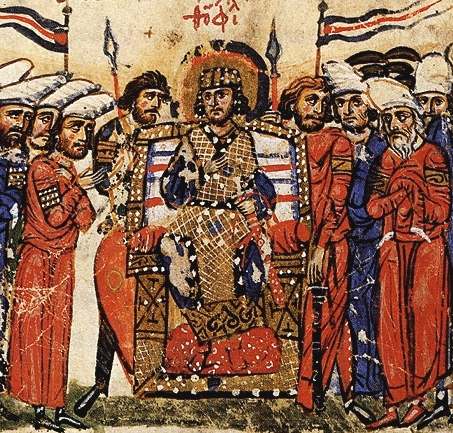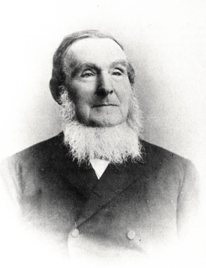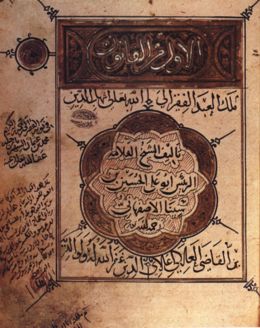|
Abu Al-Qasim Al-Baghawi
Abū al-Qāsim, Abd Allāh ibn Muḥammad ibn 'Abd Allāh al-'Azīz al-Baghawī (829CE - 929CE) ( kunya: Ibn Bint Munī') was a jurist in Baghdad. Al-Marzubānī was his pupil. Works Among his books were: *''Kitāb al-Mu’jam'' () ‘Large Alphabetical Book’ ; *''Kitāb al-Mu’jam aṣ-Saghīīr'' () ‘Small Alphabetical Book’; *''Kitāb al-Musnad'' (); *''Kitāb as-Sann ‘alā madhahib al-fiqha'' () The Ordinances According to the Legal Systems of the Jurists. Bibliography * * * * * See also *List of Arab scientists and scholars This is a list of Arab scientists and scholars from the Muslim World, including Al-Andalus (Spain), who lived from antiquity up until the beginning of the modern age, consisting primarily of scholars during the Middle Ages. For a list of cont ... Notes References {{DEFAULTSORT:Abu al-Qasim al-Baghawi 829 births 929 deaths 10th-century jurists 10th-century writers Scholars from the Abbasid Caliphate Iraqi writers ... [...More Info...] [...Related Items...] OR: [Wikipedia] [Google] [Baidu] |
Kunya (Arabic)
A ''kunya'' ( ar, كُنية) is a teknonym in Arabic names, the name of an adult usually derived from their oldest child. A kunya is a component of an Arabic name, a type of epithet, in theory referring to the bearer's first-born son or daughter. By extension, it may also have hypothetical or metaphorical references, e.g. in a ''nom de guerre'' or a nickname, without literally referring to a son or a daughter. Use of a kunya implies a familiar but respectful setting. A kunya is expressed by the use of ''Abu (Arabic term), abū'' (father) or ''Umm (given name), umm'' (mother) in a idafah, genitive construction, i.e. "father of" or "mother of" as an honorific in place of or alongside given names in the Arab world and the Islamic world more generally. General use ''Abu (Arabic term), Abū'' or ''Umm (given name), Umm'' precedes the son's or daughter's name, in a Iḍāfah, genitive construction (''ʼiḍāfa''). For example, the English Language, English equivalent would be to call ... [...More Info...] [...Related Items...] OR: [Wikipedia] [Google] [Baidu] |
Gustav Leberecht Flügel
Gustav Leberecht Flügel (February 18, 1802 – July 5, 1870) was a German orientalist. Life After attending high school in his native city Flügel studied theology and philosophy in Leipzig. He soon discovered his passion for oriental languages, which he studied in Vienna and Paris. In 1832 he became a professor at the '' Fürstenschule'' (''Ducal'' or ''Princely school'') of St. Afra in Meissen. However, he resigned in 1850 on health grounds. From 1851 he worked at the ''Fürstenbibliothek'' in Vienna on the cataloguing of Arabic, Turkish and Persian manuscripts. In December 1857 he became a corresponding member of the Russian Academy of Sciences in Saint Petersburg and, in 1859, a full member of the Saxon Academy of Sciences. In 1864 he was admitted as a foreign member of the Bavarian Academy of Sciences. Flügel 's main work was the creation of a bibliographic and encyclopaedic lexicon of Haji Khalfa, with Latin translation (London and Leipzig, 1835-1858). Particular impo ... [...More Info...] [...Related Items...] OR: [Wikipedia] [Google] [Baidu] |
10th-century Writers
1 (one, unit, unity) is a number representing a single or the only entity. 1 is also a numerical digit and represents a single unit of counting or measurement. For example, a line segment of ''unit length'' is a line segment of length 1. In conventions of sign where zero is considered neither positive nor negative, 1 is the first and smallest positive integer. It is also sometimes considered the first of the infinite sequence of natural numbers, followed by 2, although by other definitions 1 is the second natural number, following 0. The fundamental mathematical property of 1 is to be a multiplicative identity, meaning that any number multiplied by 1 equals the same number. Most if not all properties of 1 can be deduced from this. In advanced mathematics, a multiplicative identity is often denoted 1, even if it is not a number. 1 is by convention not considered a prime number; this was not universally accepted until the mid-20th century. Additionally, 1 is the s ... [...More Info...] [...Related Items...] OR: [Wikipedia] [Google] [Baidu] |
10th-century Jurists
1 (one, unit, unity) is a number representing a single or the only entity. 1 is also a numerical digit and represents a single unit of counting or measurement. For example, a line segment of ''unit length'' is a line segment of length 1. In conventions of sign where zero is considered neither positive nor negative, 1 is the first and smallest positive integer. It is also sometimes considered the first of the infinite sequence of natural numbers, followed by 2, although by other definitions 1 is the second natural number, following 0. The fundamental mathematical property of 1 is to be a multiplicative identity, meaning that any number multiplied by 1 equals the same number. Most if not all properties of 1 can be deduced from this. In advanced mathematics, a multiplicative identity is often denoted 1, even if it is not a number. 1 is by convention not considered a prime number; this was not universally accepted until the mid-20th century. Additionally, 1 is the s ... [...More Info...] [...Related Items...] OR: [Wikipedia] [Google] [Baidu] |
929 Deaths
9 (nine) is the natural number following and preceding . Evolution of the Arabic digit In the beginning, various Indians wrote a digit 9 similar in shape to the modern closing question mark without the bottom dot. The Kshatrapa, Andhra and Gupta started curving the bottom vertical line coming up with a -look-alike. The Nagari continued the bottom stroke to make a circle and enclose the 3-look-alike, in much the same way that the sign @ encircles a lowercase ''a''. As time went on, the enclosing circle became bigger and its line continued beyond the circle downwards, as the 3-look-alike became smaller. Soon, all that was left of the 3-look-alike was a squiggle. The Arabs simply connected that squiggle to the downward stroke at the middle and subsequent European change was purely cosmetic. While the shape of the glyph for the digit 9 has an ascender in most modern typefaces, in typefaces with text figures the character usually has a descender, as, for example, in . The mod ... [...More Info...] [...Related Items...] OR: [Wikipedia] [Google] [Baidu] |
829 Births
__NOTOC__ Year 829 ( DCCCXXIX) was a common year starting on Friday (link will display the full calendar) of the Julian calendar. Events By place Byzantine Empire * October 2 – Emperor Michael II dies after an 8-year reign in Constantinople, and is succeeded by his 16-year-old son Theophilos, as sole emperor of the Byzantine Empire. He continues his father's ideology of iconoclasm.Timothy E. Gregory, ''A History of Byzantium'', (Blackwell Publishing Ltd, 2010), p. 227. * October – Battle of Thasos: Saracens from the newly founded Emirate of Crete almost annihilate the Byzantine fleet at Thasos, close to the coast of Thrace. The Cyclades and other islands in the Aegean Sea are pillaged. Europe * Emperor Louis the Pious appoints his 6-year-old son Charles (by his second wife Judith) as ruler of the Frankish subkingdom Alamannia, enraging his eldest son and co-emperor Lothair I, who begins an insurrection. * Viking chieftain Halfdan the Black becomes king ... [...More Info...] [...Related Items...] OR: [Wikipedia] [Google] [Baidu] |
List Of Arab Scientists And Scholars
This is a list of Arab scientists and scholars from the Muslim World, including Al-Andalus (Spain), who lived from antiquity up until the beginning of the modern age, consisting primarily of scholars during the Middle Ages. For a list of contemporary Arab scientists and engineers see List of modern Arab scientists and engineers Both the Arabic and Latin names are given. The following Arabic naming articles are not used for indexing: :*''Al'' - the :* ''Ibn'', ''bin'', ''banu'' - son of :* ''abu, abi'' - father of, the one with A *Ali (601, Mecca – 661, Kufa ), Arabic grammarian, rhetoric, theologian, exegesis and mystic * Aisha (613, Mecca – 678, Medina), Islamic scholar, hadith narrator, her intellect and knowledge in various subjects, including poetry and medicine. *Abbas Ibn Firnas, astronomer, mathematician, physicist, inventor * Aisha al-Bauniyya (1402–1475), an Arab woman Sufi master and poet *Avempace (1085, Zaragoza – 1138, Fez), philosopher, astronomer ... [...More Info...] [...Related Items...] OR: [Wikipedia] [Google] [Baidu] |
Göttingen
Göttingen (, , ; nds, Chöttingen) is a college town, university city in Lower Saxony, central Germany, the Capital (political), capital of Göttingen (district), the eponymous district. The River Leine runs through it. At the end of 2019, the population was 118,911. General information The origins of Göttingen lay in a village called ''Gutingi, ''first mentioned in a document in 953 AD. The city was founded northwest of this village, between 1150 and 1200 AD, and adopted its name. In Middle Ages, medieval times the city was a member of the Hanseatic League and hence a wealthy town. Today, Göttingen is famous for its old university (''Georgia Augusta'', or University of Göttingen, "Georg-August-Universität"), which was founded in 1734 (first classes in 1737) and became the most visited university of Europe. In 1837, seven professors protested against the absolute sovereignty of the House of Hanover, kings of Kingdom of Hanover, Hanover; they lost their positions, but be ... [...More Info...] [...Related Items...] OR: [Wikipedia] [Google] [Baidu] |
Ferdinand Wüstenfeld
Heinrich Ferdinand Wüstenfeld (31 July 1808 – 8 February 1899) was a German orientalist, known as a literary historian of Arabic literature, born at Münden, Hanover. He studied theology and oriental languages at Göttingen and Berlin. He taught at Göttingen, becoming a professor there (1842–90). He published many important Arabic texts and valuable works on Arabic history. Writings and translations *Navavi, Liber concinnitatis nominum (1832) * (1833–34) * (1835) *Ibn Challikan, Vitae illustrium virorum (1835–50) *Geschichte der Arabischen Ärzte und Naturforscher (1840) *Navavi, ''Tahdhib al-Asma'', Biographical dictionary of illustrious men (4 bd, 1842–47) The biographical dictionary of illustrious men, chiefly at the beginning of Islamism; now first ed. from the collation of two mss. at Göttingen and Leiden (1842)*Makrizi, Geschichte der Kopten (1846) *Zakariya al-Qazwini, ‘Aja'ib al-makhluqat, Zakarija Ben Muhammed Ben Mahmud el-Cazwini's Kosmographie (2 v ... [...More Info...] [...Related Items...] OR: [Wikipedia] [Google] [Baidu] |
Nawawi
The Arabic attributive title Nawawi ( ar, النووي), denoting an origin from Nawa, Syria, may refer to: * Al-Nawawi (1233–1277), Sunni Muslim author on Fiqh and hadith * Aznil Nawawi (born 1962), Malaysian actor * Mirnawan Nawawi (born 1971), Malaysian field hockey player * Nawawi Ahmad, Malaysian politician * Nik Zul Aziz Nawawi (born 1987), Malaysian footballer * Uston Nawawi Uston Nawawi (born 6 September 1978 in Sidoarjo, East Java, Indonesia) is a retired Indonesian footballer who last played as a midfielder for Deltras Sidoarjo. He is former player of the Indonesia national team. His cousin, Rendy Irawan, is also ... (born 1978), Indonesian footballer {{Surname Nisbas Arabic-language surnames ... [...More Info...] [...Related Items...] OR: [Wikipedia] [Google] [Baidu] |
Leipzig
Leipzig ( , ; Upper Saxon: ) is the most populous city in the German state of Saxony. Leipzig's population of 605,407 inhabitants (1.1 million in the larger urban zone) as of 2021 places the city as Germany's eighth most populous, as well as the second most populous city in the area of the former East Germany after (East) Berlin. Together with Halle (Saale), the city forms the polycentric Leipzig-Halle Conurbation. Between the two cities (in Schkeuditz) lies Leipzig/Halle Airport. Leipzig is located about southwest of Berlin, in the southernmost part of the North German Plain (known as Leipzig Bay), at the confluence of the White Elster River (progression: ) and two of its tributaries: the Pleiße and the Parthe. The name of the city and those of many of its boroughs are of Slavic origin. Leipzig has been a trade city since at least the time of the Holy Roman Empire. The city sits at the intersection of the Via Regia and the Via Imperii, two important medieval trad ... [...More Info...] [...Related Items...] OR: [Wikipedia] [Google] [Baidu] |
Ibn Al-Nadim
Abū al-Faraj Muḥammad ibn Isḥāq al-Nadīm ( ar, ابو الفرج محمد بن إسحاق النديم), also ibn Abī Ya'qūb Isḥāq ibn Muḥammad ibn Isḥāq al-Warrāq, and commonly known by the ''nasab'' (patronymic) Ibn al-Nadīm ( ar, ابن النديم; died 17 September 995 or 998) was an Arab Muslim bibliographer and biographer of Baghdad who compiled the encyclopedia ''Kitāb al-Fihrist'' (''The Book Catalogue''). Biography Much known of al-Nadim is deduced from his epithets. 'Al-Nadim' (), 'the Court Companion' and 'al-Warrāq () 'the copyist of manuscripts'. Probably born in Baghdad ca. 320/932 he died there on Wednesday, 20th of Shaʿban A.H. 385. He was a Persian or perhaps an Arab. From age six, he may have attended a ''madrasa'' and received comprehensive education in Islamic studies, history, geography, comparative religion, the sciences, grammar, rhetoric and Qurʾanic commentary. Ibrahim al-Abyari, author of ''Turāth al-Insaniyah'' says al-Nadim s ... [...More Info...] [...Related Items...] OR: [Wikipedia] [Google] [Baidu] |






